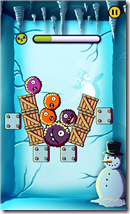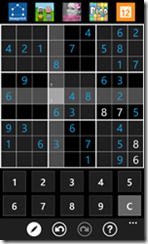Mobile games are hot and profitable, which makes them a pretty smart bet for independent developers. Overall, games make up one third of all Windows Phone downloads and 60% of revenue. Indie games are seeing downloads increase by 253% on average per month, with a 155% increase in revenue on average per month over the past year. Popular Windows Phone tools and technologies, combined with middleware support from Unity, Marmalade, Corona, and others make it easier than ever to build great Windows Phone and Windows gaming experiences across multiple devices and geographies.
With game developers converging on GDC NEXT in L.A. this week, we thought we’d kick off a new series of posts that feature advice from the developers of some the best titles in the Windows Phone Store. Today we’ll focus on games and the people behind the indie hits Monster Stack 3, SongArc, Sudoku, and Ragdoll Run.
Monster Stack 3 – Michael Kloubkov. Health Pack Games Inc.
Monster Stack 3, a fresh take on physics games that delivers HD graphics, is the brain child of Michael Kloubkov. “The Monster Stack series began as a physics experiment,” Michael shared in an email last week. “While playing around with a physics engine, stacking things on top of each other seemed very intuitive. When Windows Phone 7 was getting market traction, we decided to take a small risk and make a few games for the new platform.”
Steady market gains and easy access to great tools prompted Kloubkov to take a chance on Windows Phone. “With no mobile game development experience, XNA seemed like the obvious choice,” said Michael. “Monster Stack launched just 2 months after we started developing for Windows Phone 7. We then took 3 months to greatly improve upon three main aspects of the game: UI, Graphics and Social Features. With these three things in mind, we created Monster Stack 2 which quickly jumped to #1 in 11 countries. Its success was boosted with Windows Phone 8 which launched while Monster Stack 2 was in [the] top 10. Monster Stack 3 was in development for 6 months, during which time we created a brand-new engine in C++ and added animated monsters to the game.” Michael credits designer Richard Shilling for much of the game’s rich art and design, and they “couldn’t have done it without him.”
Monster Stack 3 is off to a great start, thanks in part to some lessons that Michael and his team learned along the way. “We’re about to hit 5,000,000 unique downloads on Windows Phone which is a huge milestone for us. We’ve seen amazing growth in 2013 for the Windows Phone market and it seems like there is still a lot of room for us to grow. If you want to succeed in the growing market of Windows Phone, you will have to experiment.
We diversify our monetization greatly from game to game. Some games are paid, some are free with advertising, and others have in-app purchases. If you are starting with Windows Phone development then you should try Microsoft Advertising.”
SongArc – András Velvárt, Response (@vbandi), Microsoft MVP and Nokia Developer Champion
SongArc is a new game from Turtle Games and the Response team that lets you get hands-on with your favorite music. With a five-star rating, SongArc is the top music game in the Windows Phone Store. SongArc is also a product of AppCampus, the joint investment between Microsoft, Nokia, and Aalto University to help developers and entrepreneurs establish new businesses though app development on Windows Phone. SongArc is one of 40 exclusive titles and 180 new ideas that AppCampus has sponsored so far.
With SongArc, András saw an opportunity to bring his passion for music to Windows Phone by creating an experience that is truly optimized for the phone. “As a hobby musician without enough free time to actually play in a band anymore, I’ve been a huge fan of music games such as Guitar Hero, Rock Band and RockSmith,” András told us. “These games can give me back a little bit of the experience of playing in a real band. But no mobile game could awaken the same feeling – so I started working on SongArc.”
The basic concept for SongArc is deceptively simple but difficult to master – like most great mobile games. As you play a song of your choice, a series of shapes move down the screen in sync with the music you are hearing (this pairing is known as a Sheet). The player must tap the shapes as they reach an arc at the bottom of the screen, creating the illusion of playing along with the song.
SongArc can express complex melodies: notes, bends, harmonies, and even drums with natural, easy-to-learn gestures. People can play with songs that they already have, create Sheets for these songs with the built-in Sheet Creator, or download a Sheet from the SongArc community. “Dancing with your thumbs to the music this way makes you appreciate the music and the artist even more,” says András.
So how did they do it? András started with a prototype, then enlisted the help of two Imagine Cup winners (Ádám Kapos and Dávid Kiss from Turtle Games) before submitting the idea to AppCampus. “With the AppCampus grants we were finally able to dedicate enough time to the project and hire some additional experts,” he said.
Under the hood, SongArc isn’t quite as simple as it appears to fans. András said that “a big challenge was to design and implement the Sheet Creator – after all, the small display of the form is much better suited for consuming content than creating it.”
“The biggest fear we had before launching the game was that people wouldn’t create Sheets,” András confessed. “In the game, you play with content created by the community, so if Sheets wouldn’t have been created, the whole game wouldn’t have been able to take off. Fortunately, this is not the case – after just four weeks, we have 13,000 Sheets for almost as many songs. On average 15 to 35 Sheets get created per hour.
As the game’s fan base grows, the SongArc team is constantly looking for more ways to maximize revenue. “Right now, our number one priority is to monetize the game so that we can keep developing and supporting it,” said András. “We are currently implementing a free-to-play system supported by in-app purchases. We are also looking for partnership with online music services, such as Xbox Music, Nokia Music, Spotify – and music publishers and artists.”
SongArc is definitely striking a chord with customers. “We have actually passed a quarter million downloads in four weeks. Not too shabby,” says András. “In the US store we have over 2300 ratings with an average of 4.8 stars. Our players have played through over 717,000 songs, which is an average of ~3.5 songs per user. Not surprisingly, András says one of the top request he gets is to create a version for iOS and Android. What does he say? “No, SongArc is Windows Phone exclusive for now.”
Sudoku – Fons Sonnemans (@fonssonnemans)
Every device needs a great Sudoku game and Fons Sonnemans saw an opportunity to build one for Windows Phone – with a little help. ”I created my first apps for my mother in law,” Fons told us. “She used to solve Sudoku puzzles from the newspaper. It was a challenge for me to see whether I could develop a Windows Phone app. I have now developed more than 20 Windows Phone apps and 12 Windows 8 apps. The success of my apps has made me decide to focus more on app development.”
Like many devs we talked with, the familiarity of Windows Phone tools made the platform more attractive. “I have developed software using Microsoft technologies for more than 20 years,” said Fons. “I was curious to see whether I could use my experience to develop Windows Phone apps and later also Windows 8 (XAML) apps. It really started as a hobby, but soon became an addiction.”
Fons is also among the devs taking advantage of the growing convergence between Windows Phone and Windows. “When Windows 8 was released I ported many of my Phone apps to it. Nowadays I mainly develop Windows 8 apps and then port them to Windows Phone.”
Fons tells us that for Sudoku, “I developed the apps using XAML and C#. I used Blend for the UX and Visual Studio for the code. All code was stored in the free online version of Visual Studio Team systems. I used the MVVM design pattern and some NuGet packages.
Fons learned that ads worked best for him. “I started with the paid version of Sudoku, which has a free trial. Later I created the Sudoku Free app which is ad based. I learned you can make a lot more money using ads than by selling apps. Sudoku is a game that takes a long time to play, which means a lot of ads can be shown in that time period. This makes ads profitable for this type of game. I set it up so the ads can be removed from the using an in-app purchase.”
So is it working? “The total number of downloads of my Windows Store apps exceed 1,000,000,” says Fons. “My Sudoku Free Windows Store app alone has more than 700,000 downloads.
Ragdoll Run – Mikael Litendahl, Dawnbreak Studios
Ragdoll Run was created by the two-man team of Mikael Litendahl/artist and Sebastian Cederholm/programmer, who make up Dawnbreak Studios. They are another example of developers who saw an opportunity to apply their existing C# and XNA Framework skills to an emerging Windows Phone and Windows 8 ecosystem. “Windows Phone was a fairly new platform and we figured it would be nice to grow together with it instead of jumping into a more saturated market,” Mikael told us. “The Windows Phone version of Ragdoll Run was built using XNA Game Studio and we used MonoGame to port the game for Windows 8/RT,” he added.
The secret to Ragdoll Run’s success was getting 3D right, then adding great graphics and customer-friendly monetization. “Ragdoll Run is by far our most successful game,” said Mikael. “Our initial idea was really to create a game that could appeal to a large audience. We knew that we wanted to make a freerunner, and do it in 3D instead of 2D. We also knew that if we were to make a freerunner in 3D, we would have to take advantage of that third dimension in the gameplay. There is a classic trap in game development where developers produces a 3D game which would really work better as a 2D game and we didn’t want to get stuck in that trap.”
The solution? Mikael says they came up with the idea “to let the player rotate the entire stage instead of only jumping to avoid obstacles, a feature which we would not have been able to pull off in a two dimensional game world.” For design inspiration the team spent quality time with an important focus group, Mikael’s four-year-old son. “We knew early on that we wanted to have a really cute art style for the game and ragdolls [were] the perfect characters to build the game around,” said Mikael. “I often asked my son to look at art I [made], and watch his reaction.”
Ragdoll Run in monetized through a mix of free and premium versions, with a focus on nonintrusive ads. “We have a free version, as well as a Premium version for $0.99, which features characters that cannot be unlocked in the free version,” said Mikael. “The player also gets 25,000 ragdollars (the in-game currency of Ragdoll Run) to start with in Premium, which normally costs $1.99. We chose to do it like this because we really prefer for our gamers to play the game without ads, since ads can hurt the gameplay.”
So far so good for Mikael and Sebastian. They tell us that “Ragdoll Run has got over 3 million downloads and was the #1 free game all over the world on Windows Phone for quite some time. We believe that a lot of Ragdoll Run’s success lies in our decision to not just release a game and call it a day, but instead keep working on it and improving the app. A great app should not feel like a product, but a service.
These are just a few of the indie game devs who are making money with Windows Phone. We hear from developers every day with amazing stories like this and would love to hear from you, too. Tell us what you’re up to, what’s working and what’s not, on Twitter at @WPDEV. If you’re at GDC NEXT and want talk about brining your game idea to life on Windows Phone, come by our booth and see us.




